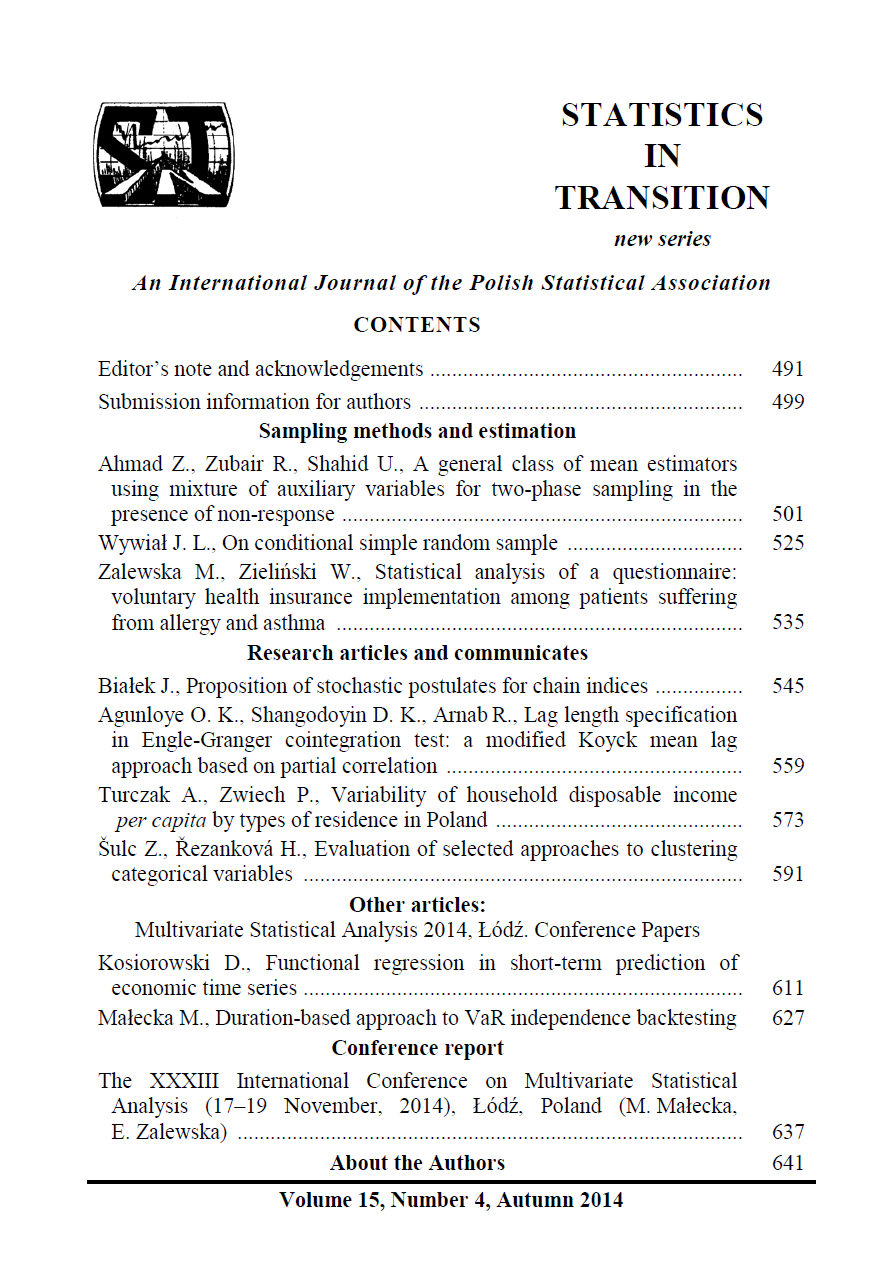ARTICLE
ABSTRACT
The Engle-Granger cointegration test is highly sensitive to the choice of lag length and the poor performance of conventional lag selection criteria such as standard information criteria in selecting appropriate optimal lag length for the implementation of the Engle-Granger cointegration test is well-established in the statistical literature. Testing for cointegration within the framework of the residual-based Engle-Granger cointegration methodology is the same as testing for the stationarity of the residual series via the augmented Dickey-Fuller test which is well known to be sensitive to the choice of lag length. Given an array of candidate optimal lag lengths that may be suggested by different standard information criteria, the applied researchers are faced with the problem of deciding the best optimal lag among the candidate optimal lag lengths suggested by different standard information criteria, which are often either underestimated or overestimated. In an attempt to address this well-known major pitfall of standard information criteria, this paper introduces a new lag selection criterion called a modified Koyck mean lag approach based on partial correlation criterion for the selection of optimal lag length for the residual-based Engle-Granger cointegration test. Based on empirical findings, it was observed that in some instances over-specification of lag length can bias the Engle-Granger cointegration test towards the rejection of a true cointegration relationship and non-rejection of a spurious cointegration relationship. Using real-life data, we present an empirical illustration which demonstrates that our proposed criterion outperformed the standard information criteria in selecting appropriate optimal truncation lag for the implementation of the Engle-Granger cointegration test using both augmented Dickey-Fuller and generalized least squares Dickey-Fuller tests.
KEYWORDS
modified Koyck mean lag, partial correlation criterion, Engle-Granger cointegration test, optimal truncation lag, information criteria, augmented Dickey-Fuller test, generalized least square Dickey-Fuller test.
REFERENCES
AGUNLOYE, O. K., ARNAB, R., SHANGODOYIN, D. K., (2013). A New Criterion for Lag-Length Selection in Unit Root Tests. American Journal for Theoretical and Applied Statistics, Vol. 2, No. 6, 293–298.
AKAIKE, H., (1969). Fitting autoregressive models for prediction. Annals of the Institute of Statistical Mathematics, 21, 243–247.
AKAIKE, H., (1973). Information theory and an extension of the maximum likelihood principle. 2nd International Symposium on Information Theory. In: B.N. Petrov and F. Csáki, (Eds) (Budapest: Académiai Kiadó), 267–281.
BEWLEY, R., YANG, M., (1998). On the size and power of system tests for cointegration. The Review of Economics and Statistics, 80(4), 675–679.
BROOKS, C., (2002). Introductory Econometrics for Finance, Cambridge University Press.
CHEUNG, Y. W., LAI, K. S., (1993). Finite sample sizes of Johansen's likelihood ratio test for cointegration. Oxford Bulletin of Economics and Statistics, 55, 313–328.
CLARKE, J. A., MIRZA, S., (2005). A comparison of some common methods for detecting Granger noncausality. Journal of Statistical Computation and Simulation in press.
DICKEY, D. A., JANSEN, D. W., THORNTON, D. L., (1991). A Primer on Cointegration with Application to Money and Income. Review, Federal Reserve Bank of St. Louis, issue Mar., 58–78.
ELLIOTT, G., ROTHENBERG, T. J., STOCK, J. H., (1996). Efficient Tests for an Autoregressive Unit Root. Econometrica, 64, 4, 813–836.
ENGLE, R. F., GRANGER, C. W. J., (1987). Cointegration and Error Correction Representation, Estimation and Testing. Econometrica, 55: 251–257.
GONZALO, J., PITARAKIS, J. Y., (1999). Lag length estimation in large dimensional systems. Journal of Time Series Analysis, 23(4), 401–423.
GUTIERREZ, C. E. C., SOUZA, R. C., GUILLEN, O. T. D. C., (2009). Selection of Optimal Lag-length in Cointegrated VAR models with Weak Form of Common Cyclical Features. Brazilian Review of Econometrics, Vol. 29, No. 1, 59–78.
HANNAN, E. J., QUINN, B. G., (1978). “The determination of the order of an autoregression”. Journal of Royal Statistical Society, 41, 190–195.
JOHANSEN, S., (1991). Estimation and hypothesis testing of cointegration vectors in Gaussian vector autoregressive models. Econometrica, 59(6), 1551–1580.
KOYCK, L. M., (1954). Distributed Lags and Investment Analysis, Amsterdam: North-Holland.
LI, J., MOORADIAN, R. M., YANG, S. X., (2009). ”The Information Content of the NCREIF Index”, Journal of Real Estate Research, 31(1), 93–116.
LÜTKEPOHL, H., (1993). Introduction to Multiple Time Series Analysis (2nd ed.) (Berlin: Springer-Verlag).
NISHI, R., (1988). Maximum likelihood principle and model selection when the true model is unspecified. Journal of Multivariate Analysis, 27, 392–403.
SAID, E. S., DICKEY, D. A., (1984). Testing for a Unit Root in Autoregressive Moving Average Models of Unknown Order. Biometrika, 71, 3, 599–607.
SCHWARZ, G., (1978). Estimating the dimension of a model. Annals of Statistics, 6, 461–464
